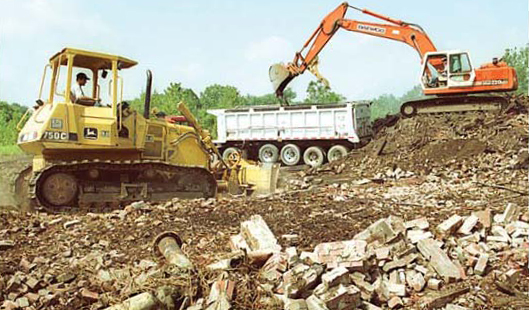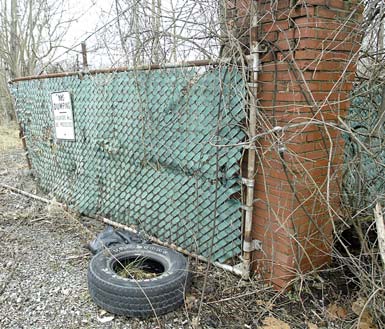Transforming a tannery


Workers from D&A Excavating of Canfield remove debris from the site of the former Ohio Leather Co. along North State Street in Girard. Although the demolition took place more than 10 years ago, the site of the once-sprawling leather factory remains contaminated. Above, the plant is pictured in its heyday in the 1940s.

A “No Dumping” sign stands at the contaminated site of the former Ohio Leather Co. property off U.S. Route 422 in Girard. After more than a decade of negotiations with the owners, the city decided Tuesday to obtain the land via foreclosure procedures.
By Robert Guttersohn
rguttersohn@vindy.com
GIRARD
After years of failed negotiations over the contaminated Ohio Leather Co. property, the city began the process of obtaining the 27 acres through foreclosure Tuesday.
Mayor James Melfi requested the city’s legal counsel use the $75,000 lien Girard placed on the property as leverage for the foreclosure.
The Ohio Leather Works operated along U.S. Route 422 for more than 70 years, taking skin hides from stockyards in Chicago and making leather apparel.
Unable to compete with cheaper imports, the tannery closed in 1971.
According to Vindicator records, Maryland investors bought the structure in 1995 with plans of turning it into an apartment complex. But arson gutted the building later that year. Melfi said to prevent the fire-damaged structure from falling onto Route 422, the city paid for the demolition of the plant and placed the $75,000 cost on the owner. He said the owners still have not paid for the demolition, despite court orders to do so.
After the fire, the city worked with the Ohio Environmental Protection Agency in negotiating with the property’s owner on buying the land.
But Melfi said the negotiations “stalled.”
“We now want to begin the foreclosure process and obtain the property that way,” Melfi said.
The owners, Navy Friends Inc., could not be reached on Tuesday.
Melfi is hedging on the belief that when Girard calls for the property owner to pay the $75,000, the owners will not be willing to put up the money for the contaminated site.
But the Clean Ohio grant program, which set aside money for local governments to demolish and clean contaminated industrial sites and a grant the city was counting on, is set to expire in June.
“Clean Ohio is sort of up in the air at this moment,” said Rodney Beals, an environmental manager with the Ohio EPA, who has worked with Girard on obtaining the property.
He said he plans to look into other sources of funding for the cleanup.
The cost of cleanup is unknown because more than 15 years after the fire that led to the demolition of the building, the EPA still does not know the extent of the property’s contamination, said Andrew Kocher, an EPA site coordinator.
“We don’t know what’s underneath the building,” Kocher said.
Kocher said past investigators found traces of hexavalent chromium, the solution chemicals used on leather, on the outskirts of the property. Because cement rubble still covers the basement, the EPA’s probe could not test the solution tanks in the basement.
Kocher said the property would require on-site testing using construction equipment to move the rubble and test the holding tanks, and then the immediate removal of the tanks.
“What we’re hoping for is future grant money to investigate the site,” Kocher said.
Melfi said he has ideas for the future of the site but refrained from elaborating.
“Those are dreams, now,” he said. “We don’t want to get too far ahead of ourselves.”
 43
43
